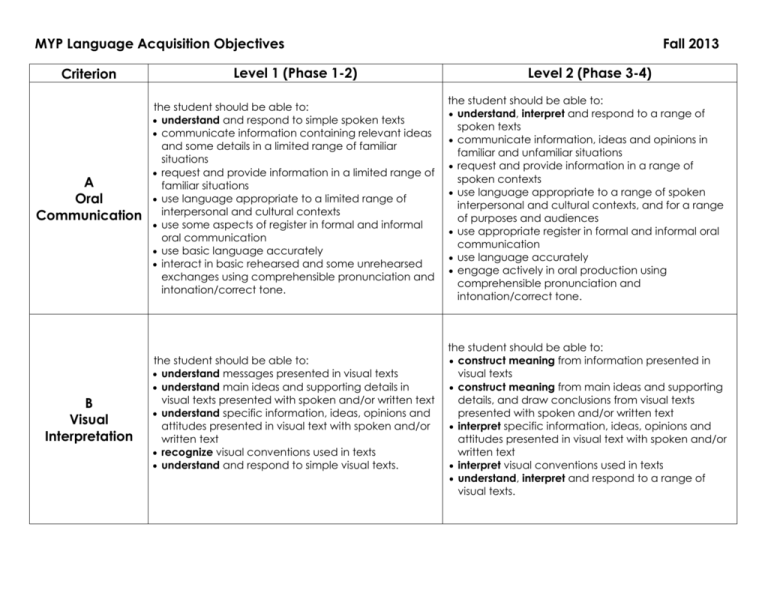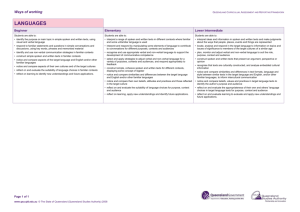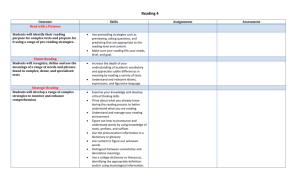Lang Acq Objectives
advertisement

MYP Language Acquisition Objectives Criterion Level 1 (Phase 1-2) A Oral Communication the student should be able to: understand and respond to simple spoken texts communicate information containing relevant ideas and some details in a limited range of familiar situations request and provide information in a limited range of familiar situations use language appropriate to a limited range of interpersonal and cultural contexts use some aspects of register in formal and informal oral communication use basic language accurately interact in basic rehearsed and some unrehearsed exchanges using comprehensible pronunciation and intonation/correct tone. the student should be able to: understand messages presented in visual texts understand main ideas and supporting details in B Visual Interpretation visual texts presented with spoken and/or written text understand specific information, ideas, opinions and attitudes presented in visual text with spoken and/or written text recognize visual conventions used in texts understand and respond to simple visual texts. Fall 2013 Level 2 (Phase 3-4) the student should be able to: understand, interpret and respond to a range of spoken texts communicate information, ideas and opinions in familiar and unfamiliar situations request and provide information in a range of spoken contexts use language appropriate to a range of spoken interpersonal and cultural contexts, and for a range of purposes and audiences use appropriate register in formal and informal oral communication use language accurately engage actively in oral production using comprehensible pronunciation and intonation/correct tone. the student should be able to: construct meaning from information presented in visual texts construct meaning from main ideas and supporting details, and draw conclusions from visual texts presented with spoken and/or written text interpret specific information, ideas, opinions and attitudes presented in visual text with spoken and/or written text interpret visual conventions used in texts understand, interpret and respond to a range of visual texts. Criterion C Reading Comprehension D Writing Level 1 (Phase 1-2) Level 2 (Phase 3-4) the student should be able to: understand basic facts in written texts understand main ideas and supporting details, and draw some conclusions from written texts recognize basic aspects of format and style understand and respond to simple written texts. the student should be able to: interpret specific information, ideas, opinions and attitudes presented in written texts interpret main ideas and supporting details, and draw conclusions from written texts interpret aspects of format and style in written texts understand, interpret and respond to a range of written texts. the student should be able to: communicate information containing relevant ideas and some details in a limited range of familiar situations request and provide information in a limited range of familiar situations use language appropriate to a limited range of interpersonal and cultural contexts understand and use basic language conventions accurately use some aspects of register in formal and informal written communication. the student should be able to: communicate information, ideas and opinions in familiar and unfamiliar situations request and provide information in a range of written contexts use language appropriate to a range of interpersonal and cultural contexts, and for a range of purposes and audiences understand and use language conventions accurately use appropriate register in formal and informal written communication. Analyse Break down in order to bring out the essential elements or structure. To identify parts and relationships, and to interpret information to reach conclusions. Construct meaning Create an understanding about something; infer and interpret facts, an opinion, an idea or an event that has been read, viewed, listened to. Evaluate Assess the implications and limitations; make judgments about the ideas, works, solutions or methods in relation to selected criteria. Identify Provide an answer from a number of possibilities. Recognize and state briefly a distinguishing fact or feature. Interpret Use knowledge and understanding to recognize trends and draw conclusions from given information. Recognize Identify through patterns or features. Synthesize Combine different ideas in order to create new understanding. Understand Comprehend the meaning or significance of something and explain it in a different way.









